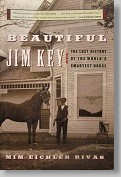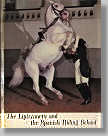"The wind of Heaven is that which
blows between a horse's ears."
-Arabian proverb
|
|    Back cover: Portrait of Charles VI, Emperor of the Holy Roman Empire, astride a prized stallion, circa 1735.
| 
At the end of the 19th century, America - indeed the entire Western world - was transitioning. The Industrial Revolution was advancing full steam ahead, and the old ways of doing things, though falling out of favor, were desperately clung to for their familiarity. America, which was just coming out of its golden age of spiritualism, was no exception. Horse whispering, in particular, was one
of these familiar tasks, getting a leg-up in popularity due to the unexplainable - therefore occult - communication between one species and another. Although horse whisperers had been around since equines were first domesticated, in an age of progress that promised to eliminate the need for working livestock, there was an unlikely resurgence of curiosity in the old, familiar craft.
Beautiful Jim Key: The Lost History of the World's Smartest Horse is a painstakingly researched biography by Mim Eichler Rivas. Its thought-provoking story centers around the star of the show, Jim Key, a horse of preternatural talent. He counted, read, and gave improvisational performances to sold-out crowds at the turn-of-the-century. His owner, William "Doc" Key, was no less sensational than Jim, and his promoter, Albert Rogers, even more sensational with his promotions than either of them. Combined, they were an unstoppable force for the lime-light.
Promotional Consideration
Styling himself after P. T. Barnum, Rogers never met a risk he wasn't willing to take. In Doc and Jim Key, he undoubtedly saw dollar signs, but they appealed to his philanthropical side too. While he was best known for his promotional genius (he had exclusive rights to a variety of amusements at fairs and expositions prolific at the time, including the Mirror Maze, a precursor to that carnival standard, House of Mirrors), he held a special place in his heart for the humane treatment of animals. This, he soon discovered, was something he shared with Doc, and together they made a determined
effort to use Jim Key's fame to further the cause.
Medicine Man
At an early age, Doc showed signs of psychic intuition. He was one of those people that animals and the infirmed flock to, whether out of a sense of compassion or safety. At a young age he garnered a reputation as having a sixth sense about animals, and neighbors often "employed" him to deal with theirs, eventually becoming a self-taught veterinarian. That same gift he also applied to people, taking care of Strother Key (John's father) with the same compassion he showed the beasts of the barn. When the Civil War began, he even pursued Key's sons to the front in a successful effort to
ensure their safety. An occultist, veterinarian, poker player, snake oil salesman (he developed his own line of curative mineral-based liniment from knowledge passed down by his Native American mother), horse whisperer - Doc Key was everything suspect you could ask for in a caregiver.
By the mid-1880's, Doc had amassed a small fortune. Although the war and Emancipation Proclamation had technically freed him, he was still a Black man, in America. That came with distinct challenges, but mostly it meant keeping his head down. Though he was educated, he'd best not show it. Though he was wealthy, he'd best not flaunt it. The decade from 1892 to 1902 saw an average of two lynchings per week, with little or no investigations. At the end of the nineteenth century, humility was the only trait afforded a person of color in America.
All the King's Horses
When Doc Key found Lauretta Queen of Horses in 1887, she was several circuses removed from her glory days. Though a bit tarnished, Doc still saw potential in her. He purchased Lauretta - a horse that had once fetched $50,000 - for the modest sum of $40, and her sellers thought they were getting the deal of a lifetime. Doc had taken an interest in harness racing, and with Lauretta he hoped to breed a champion from her royal bloodline. The result: Jim Key.
A Star is Born
their belly is a treasure and their back a seat of honor."
By 1906, due in significant part to Rogers, Doc, and Jim, the cause for the humane treatment of animals was a significant force. Precursors to today's Humane Society, ASPCA and their ilk were springing up in metropolitan areas across the land. The trinity - led by Jim Key - took on a seemingly holy presence in the eyes of some Americans for their pursuit of animal welfare, their appearances sparking a religious fervor among attendees. But alas, traveling and performing take their toll, even on the smartest horse in the world. Jim Key suffered bouts of lameness, which ultimately curtailed touring altogether. In 1907, Jim Key retired to Doc's farm in Shelbyville, Tennessee. Soon after, interest in the performing horse waned, dashing any hopes Rogers had of pulling him out of retirement. His life's work was complete. He'd been taught by kindness, and had shared it as a philosophy with countless fairgoers, ultimately improving the general treatment of animals. On September 18, 1912, having outlived Doc by three years, Beautiful Jim Key met his maker. His headstone is inscribed: "Kindness, Justice, Mercy to All Creatures." Perhaps an addition to the inscription is called for. A shout out to Beautiful Jim Key's author whom, through exhaustive research, has resurrected this most fascinating of stories about the smartest horse in the world.
The Spanish Riding School has a long, rich history. Its earliest records date back to 1562 when the groundwork was laid in Vienna in the form of a Rosstummelplatz, literally an "exercise ground for horses." Before long, it was apparent working out the horses in the open air in all seasons, wasn't the best plan. So, in 1572 a wooden structure was erected to fend off the elements, and it was christened the Spanish Riding Hall. This structure served its purpose until 1735, when the school was relocated to the former site of an imperial garden under the watchful eye of Emperor Charles VI, and a new, elegant Riding Hall - complete with chandeliers - built at his direction. It marked the birth of modern dressage. Equestrian arts have been around practically forever. The Greek historian and cavalry officer Xenophon documented them in antiquity. Recorded in the fourth century BC, his were the only documentation on the subject until the 16th century. It seems unfathomable, but other writings - and we know they existed because Xenophon referenced them - were lost to the weeds of history. So, it was not a thing of unimportance, the establishment of the Riding School, and the bolstering commitment to it of Charles VI. Today, the Spanish Riding School ("Spanish" because their horses are descendents of the all but lost great steeds of a glorified Spanish line) seems quaint and unnecessary as a national treasure, like Lenin's tomb (Russia) or Punxsutawney Phil (USA). But after reading the school's history, while it still seems the product of a lost era of pomposity, the thinking behind its function can at least be appreciated. And the story isn't all stirrups and lunging reins. The Lippizzaner's success is a lesson at odds with the very civilization that established their exclusive bloodline. The last 500 years of European history hasn't exactly been known for peace. As if border disputes aren't bad enough, Europe's also been rocked by revolution, coups and two world wars, each new conflict displacing the famous stallions worse than the last. In 1792, the entire stud was marched for fourteen days to a safe haven in Stuhlweissenburg ahead of the advancing French army. That they made the trek without incident is a credit to superior genetics. In their conquest, the French laid waste to the stud, then in 1803 an earthquake leveled it just as its reconstruction was nearing completion. World War I - with the fall of the Austro-Hungarian Empire in 1918 - marked the end of the stud's exclusive imperial service, resulting in the stock being divided between Austrian and Italian management. With the onslaught of the second World War, the stock was reunited, now as refugees in Czechoslovakia under conditions that risked them being wiped out altogether. And they probably would have been, if not for a daring - and unauthorized - rescue from the as yet unoccupied territory, led by none other than General Patton himself. Though The Lippizzaners and the Spanish Riding School is concise, it packs a punch for its size. To his credit, Wolfgang Reuter focuses on the highlights (historical and technical) delivering a fascinating glance into Europe's oldest and finest equestrian institution. Hopefully, the Spanish School and its signature Riding Hall will survive to be enjoyed for generations to come. posted 07/15/20  TOP |

